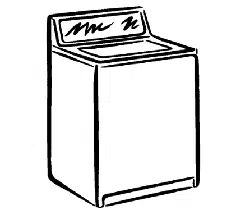Loading ...
Loading ...
Loading ...

4. Close the washer lid.
5. Turn the Water Level selector to the correct setting for your
wash load and the type of fabric being washed.
• Choose a water level that allows the load to move freely
for best fabric care. See "Loading."
• You may change to a higher level setting after the washer
has started filling by turning the knob to a different
setting.
6, Set the Water Temperature selector to the correct setting for
the type of fabric and soils being washed. Use the warmest
water safe for fabric, Follow garment label instructions.
Water Temp Use for
Hot Whites and pastels
Heavy soils
Warm Bright colors
Moderate to light soils
Cold Colors that bleed or fade
Light soils
NOTE: In wash water temperatures colder than 70°F (21°C),
detergents do not dissolve well. Soils can be difficult to
remove. Some fabrics can retain wear wrinkles and have
increased pilling (the formation of small lint-like balls on the
surface of garments).
(OPTIONAL) An Automatic Temperature Control (ATC)
electronically senses and maintains a uniform water
temperature by regulating incoming hot and cold water.
• Even in cold wash, some warm water is let into the
washer to maintain a minimum temperature of 65°F
(19°C).
• Warm wash is maintained at approximately 95°F (35°C),
• Warm rinse is maintained at approximately 70°F (21°C) for
all warm rinse settings.
7. (OPTIONAL STEP) For a second rinse at the end of the Ultra
Clean cycle or the Permanent Press IIcycle, turn the Rinse
Options selector to 2nd Rinse.
8. Set the Speeds Control knob according to the type of fabric
in the load. See "Selecting Wash/Spin Speeds."
9. Push in the Cycle Selector Control (Timer) knob and turn it
clockwise to the wash cycle you want. Reduce the wash time
when using a small load size setting. See "Selecting a Cycle
and Time."
Pull out the Cycle Selector Control (Timer) knob to start the
washer.
To stop or restart your washer
• To stop the washer at any time, push in the Cycle Selector
Control (Timer) knob.
• To restart the washer, close the lid (if open) and pull out
the Cycle Selector Control (Timer) knob.
This section describes the wash/spin speeds you can select with
the Speeds control. Each speed setting is designed for different
types of fabric and soil levels.
DELICAE NORMAL
SLOW / SLOW SLOW / FAsr
o o
HANDWASH
CASUAL o
SLOWI SLOW
HANDWASH PLUS
FINE DEUCATES
IN'i_RMffi_NT
EqRA SLOW/ SLOW
HEAVYDUTY
o FASTI FAST
o o
HANG DRY
FASTI SLOW
Speeds Selector knob
Normal speed
This speed setting is for normally soiled cottons and linens.
Setting combines slow speed agitation and fast spin speeds to
shorten drying time.
Heavy Duty speed
This speed setting is for sturdy or heavily soiled loads. Setting
combines fast speed agitation and fast spin speeds.
Hang Dry speed
This speed setting is for sturdy permanent press fabrics that will
be line dried. Setting combines fast speed agitation and slow
spin speeds to reduce wrinkling.
Handwash Plus Fine Delicates speed
Use this speed setting for hand washable and special-care items.
The wash action has repeating periods of extra-slow speed
agitation and soaking. Slow spin speeds help reduce wrinkling.
NOTE: Do not use this cycle for large items such as blankets.
Some "Hand Wash" items, particularly wool, naturally shrink
when washed. When still wet, block these items by gently
stretching to original measurements. Allow the items to dry flat.
Handwash/Casual speed
This speed setting is for lingerie and loosely knit items. Setting
combines extra-slow speed agitation for gentle soil removal and
slow spin speeds to reduce wrinkling.
Delicate speed
This speed setting is for washable knit fabrics and permanent
press fabrics. Setting combines slow speed agitation for gentle
soil removal and slow spin speeds to reduce wrinkling.
12
Loading ...
Loading ...
Loading ...
